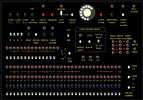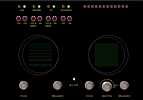Go to Antique Computer home page
Go to Visual Storage page
*** Please note, this page (and web site) are in early development.
Items are certainly not complete, and may be inaccurate.
Your information, comments, corrections, etc. are eagerly requested.
Click here to e-mail Ed.
Please include the URL under discussion. Thank you ***
English Electric's Deuce Drum
| Manufacturer | English Electric
|
| Identification,ID | -
|
| Date of first manufacture | 1955, as per
John Barrett
|
| Number (of DEUCE computers) produced | about 31, as per
John Barrett,
33, as per
Robin - March 2012
|
| Estimated price or cost | Price of whole DEUCE was £50,000. as per
Peter Docherty
|
| location in museum | -
|
| donor | Max Burnet
|
Contents of this page:
Photo
Placard
English Electric Deuce Drum (1957)
This drum was part of the English Electric Deuce, a British computer. The rapidly-spinning cylinder has a magnetic coating that could store 8,192 words of 32-bits each on 256 tracks of 32 words each. The drum rotates at 6,510 RPM. There are 16 read heads and 16 write heads in separate head arrays. The head array can be positioned to 16 track locations.
This was considered a 'second generation' drum memory; first generation drums could be enormous and very heavy, yet their low cost made them a popular choice for mid-range computers in the mid to late 1950s. This drum weighs about 60 pounds. Note the handlebars for lifting. The cylindrical assemblies on top are for positioning the head stacks after the drum comes up to speed.
Courtesy: Computer History Museum
|
Architecture
|
See 'ENGLISH ELECTRIC' D.E.U.C.E.'
in "Interesting Web Sites" below
|
Special features
from Gordon Bell - e-mail March 10, 2003
Subject: RE: EE Deuce & Paper on SODA a one level store and symbolic assembler for Deuce by Brigham and Bell
|
Note...
SODA (symbolic, optimum, deuce assembly program) converted the two
stores into a single level store.
Because some of the English machines had small main memories and backing
drum stores, they created the one level store. Just like we did in
1957-1958.
Unfortunately, it was done first at Manchester and then appeared in
Atlas.
In 1958, when I met Wilkinson at NP (that Deuce came from) to give a
talk,
he said who needs a symbolic, optimum assembly program --
(in essence) real men program in binary.
SODA was used as the back end for a Fortran compiler that got written
for DEUCE.
The runtime and memory manager was used by George, a reverse polish
notation system.
George was used as a model for the EE KDF9 Architecture.
g
|
|
Historical Notes
from Peter Gregory - Sept 30, 2016
|
Ed, I just saw your website and thought that you might like to know that we had two
DEUCE
at Bristol Aircraft Company (later part of BAC) in the late 1950’s. They were bought
primarily for trajectory simulation of the
Bloodhound surface-to-air guided weapon,
and I was responsible for trajectory simulation and so spent many hours in the control
room, pushing chads back into punched cards to modify programs and data.
I used DEUCE between 1959 and 1963. Typically, it took 5 minutes for a trajectory
simulation, but as Bloodhound2 began development, with 100 mile range, the times
grew to almost an hour. In 1963 we gained access to the IBM 7090 in IBM’s London
datacenter. The 7090 was about 45 times faster than DEUCE and later, working for
IBM we rated the 7090 at about 0.25 MIPS.
I remember that programming was “hairy chested”; the Autocoder was derided,
and program development was time-consuming, with constant scaling.
Great days!
Regards
Peter Gregory.
|
|
This Artifact
Interesting Web Sites
Other information
|
Peter Docherty (Jan 2007) wrote
|
Ed, I noted that you had no price for the deuce. In 1956/57 the price was £50,000.
I worked on the DEUCE as an engineer in Marconi House, The Strand, London WC2 from November 1956
until the end of 1961. The DEUCE it was by then in Queen's House, Kingsway. I left there to go on a
KDP10 course at Kidsgrove and helped to commission the machine which went to BOLSA
(Bank of London and South America) where I became the reaident engineer .
I have one or two circuit diagrams of the DEUCE machine.
Peter Docherty
|
John Barrett (November 2007) wrote
|
I was doing one of my irregular trawls of the WWW for Deuce references when I came across Peter Docherty's
entry on your site at http://ed-thelen.org/comp-hist/english-electric-deuce.html
Although Peter is listed on my Deuce People page http://users.tpg.com.au/eedeuce/people.html#263 it was only
by reference from someone else. I have emailed him and hope to hear from him soon.
The number of Deuce people on my site is now 445, just when I think that is the end another turns up.
David Green, http://users.tpg.com.au/eedeuce/people.html#17 who was a programmer in Kidsgrove , and later at
Sydney Uni when I went there to install a KDF9, has added a site of Deuce documents at http://members.iinet.net.au/~dgreen/deuce/deucdocs.html
I was able to give him David Leigh's address in UK, who has a mass of Deuce documents, and the two of them spend
many happy hours photocopying as much as possible http://users.tpg.com.au/eedeuce/people.html#151
David Green has spent many hours producing a Deuce Emulator and the beta version I have played with is very
impressive and brings back memories. The two emulated panels of the Deuce are attached.
Still concerned that when I pop my clogs all this history will be gone. Just don't seem to be able to
get through to museums how dependent they are on written historical documents that people reading them can
read and recognise. Not the case with floppies CDs etc. I think I've said all this before.
Cheers from Sunny Sydney - John


(click on images to enlarge)
|
|
If you have comments or suggestions, Send e-mail
to Ed Thelen
Go to Antique Computer home page
Go to Visual Storage page
Go to top
Updated Sept 2012

